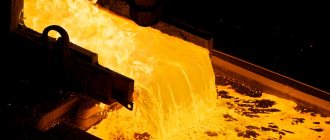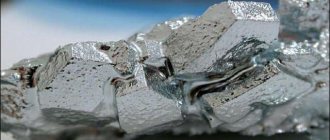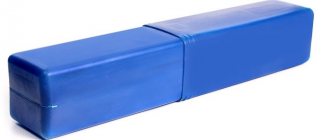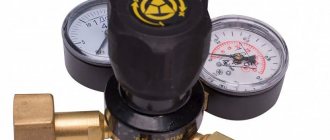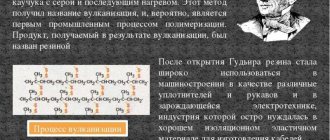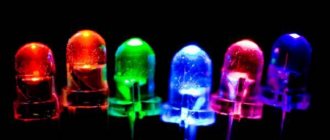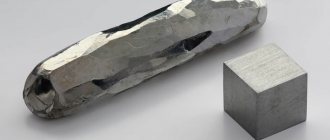The result of a good and professional welder’s work can be admired for a long time. Particularly interesting to contemplate is the color of the welds, which can take on the most bizarre shades - from light blue or dark blue to pink or light yellow. At the same time, many craftsmen are interested in whether the color of the tarnish of a weld during welding is a sign of a manufacturing defect, or whether it can be considered a side effect when working with protective gases, which can indicate the quality of the connection of metal workers. In this article we will try to find the answer to these questions.
What are tarnish colors?
These are the colors of the rainbow that appear on the smooth surface of a metal product when a special oxide film forms on it. It is this film, also called tarnish, that is a very thin layer of metal oxide, the thickness of which can vary from a few millimeters to just a few molecules. Being transparent, such a film ensures the process of interference of light rays in it, which leads to the appearance of rainbow colors, as well as their shades. As a rule, discoloration occurs when a metal product is exposed to heat, for example, during heat treatment of steel alloys or welding of metals.
Tarnish colors for metal surface finishing
When preparing regulations, one should prefer lower temperatures and longer holding times, since in this case the oxide films are more durable and the creation of additional thermal stresses, which can lead to warping of products, is eliminated.
Tarnish colors are used to decorate the surface of products made of steel, cast iron and non-ferrous metals: buckles, forgings, solar collectors, edged weapons and processing tools. This is the well-known bluing process.
For hardened and non-hardened steel, the formation of oxide films will occur differently. The rate of formation of oxide films is significantly influenced by:
- structure. Hardened steels oxidize more slowly
- surface contamination. Oil films are charred to soot, so the films will be loose and loose,
- surface roughness. On a polished surface, the film will be thinner than on a rough surface under the same conditions.
To obtain a dense, uniform film of oxides, heating furnaces are required that can maintain a stable temperature for a long time.
At home, this is either a forge, or a blowtorch, or a high-quality stove with oven. And in this case, the blackening mode is selected individually for each product. It must be remembered that the transition from one color to another occurs quickly, so the process requires the closest attention.
Author Irina Faydyuk
Color scale for tarnish of carbon steels
The thickness of the oxide films is determined by the temperature and heating time, and the existing scales of tarnish colors are rather arbitrary.
- First, visual evaluation is a highly subjective process, with results determined by lighting conditions and practical experience.
- Secondly, the density of the oxide film is also determined by the chemical composition of the alloy.
Therefore, the correspondence tables differ (for carbon, heat-resistant, stainless steels), and we can only talk about approximate compliance. But the average table of tarnish colors looks like this:
Colors
Heating temperature, °C
brown-yellow to brown
lilac
sea water color
For example, prolonged heating at 220 °C can cause steel to turn blue. Or the desired color is obtained by briefly heating to a temperature higher than that indicated in the table. But for each tarnish color there is a temperature minimum, below which the desired color will not work.
What does the color of the weld indicate?
Previously, weld colors were used to determine the temperature during heat treatment of steel alloys. However, you need to understand that this is a very inaccurate indicator, since the color will depend not only on the temperature itself, but also on other factors, for example:
- material heating rate;
- what components are included in the gas environment in which the heat treatment process takes place;
- duration of exposure of the steel alloy;
- lighting features and other things.
It is worth noting that there is a clear relationship between the resulting tarnish color and the thickness of the film itself, because the thicker it is, the shorter the waves of light reflected by it will be. For example, blue shades of a seam appear when waves of longer length, for example, orange or red, are “subtracted” from white. But the yellow color appears when the colors of short waves - blue and violet - are subtracted from the color spectrum. Thus, the blue color of the tarnish indicates that the heating temperature is quite high, while yellow indicates a lower temperature indicator.
How to determine its temperature by the color of a hot part
Heat treatment of steel parts is carried out in cases where it is necessary either to increase the strength, hardness, wear resistance or elasticity of a part or tool, or, conversely, to make the metal softer and easier to machine. Depending on the heating temperatures and the method of subsequent cooling, the following types of heat treatment are distinguished: hardening, tempering and annealing.
In amateur practice, you can use the table below to determine the temperature of a hot part by color.
| Heat color of steel | Heating temperature, degrees. WITH |
| Dark brown (visible in the dark) | 530-580 |
| Brown-red | 580-650 |
| Dark red | 650-730 |
| Dark cherry red | 730-770 |
| Cherry red | 770-800 |
| Light cherry red | 800-830 |
| Light red | 830-900 |
| Orange | 900-1050 |
| Dark yellow | 1050-1150 |
| Light yellow | 1150-1250 |
| Bright white | 1250-1350 |
Hardening of steel parts. Hardening gives the steel part greater hardness and wear resistance. To do this, the part is heated to a certain temperature, held for some time so that the entire volume of the material warms up, and then quickly cooled in oil (structural and tool steels) or water (carbon steels). Typically, parts made from structural steels are heated to 880-900 degrees (light red incandescent color), from instrumental steels - to 750-760 degrees (dark cherry red color), and from stainless steel - to 1050-1100 degrees (dark cherry red color). yellow). The parts are heated slowly at first (up to about 500 degrees), and then quickly. This is necessary to ensure that internal stresses do not arise in the part, which can lead to cracks and deformation of the material.
Operating temperature of stainless steel, temperature of application of heat-resistant steels and alloys
Tables of values of the maximum operating temperature of steel (stainless, heat-resistant and heat-resistant) of common grades for different service life are presented. The temperature at which steel begins to oxidize intensively in air is also indicated.
The tables allow you to select the required grade of stainless steel or iron-nickel alloy for certain operating conditions and a given service life.
The first table shows the operating temperature (maximum application temperature) of stainless steels and alloys based on iron-nickel and nickel bases, intended for operation in an oxidizing environment from 50 to 100 thousand hours .
According to the table, it can be seen that during ultra-long operation, the maximum operating temperature of the considered steel grades does not exceed 850°C (stainless steel 05ХН32Т), and the “margin” to the temperature of intense scaling ranges from 200 to 500 degrees.
Temperature of steel use during ultra-long operation (up to 100 thousand hours)
| Grade of steel or alloy | Maximum application temperature, °C | Temperature of the onset of intensive scale formation in air, °C |
| 05ХН32Т (EP670) | 850 | 1000 |
| 08X15N24V4TR (EP164) | 700 | 900 |
| 08Х16Н13М2Б (ЭИ680) | 600 | 850 |
| 09X16N4B (EP56) | 650 | 850 |
| 09X14N19V2BR (EI695R) | 700 | 850 |
| 09X14N19V2BR1 (EI726) | 700 | 850 |
| 09Х16Н15М3Б (ЭИ847) | 350 | 850 |
| 12X13 | 550 | 750 |
| 12Х18Н10Т | 600 | 850 |
| 12Х18Н12Т | 600 | 850 |
| 12Х18Н9Т | 600 | 850 |
| 12ХН35ВТ (ЭИ612) | 650 | 850…900 |
| 13Х14Н3В2ФР (ЭИ736) | 550 | 750 |
| 15Х11МФ | 580 | 750 |
| 16X11N2V2MF (EI962A) | 500 | 750 |
| 18Х11МNFБ (EP291) | 600 | 750 |
| 18X12VMBFR (EI993) | 500 | 750 |
| 20Х12ВНМФ (EP428) | 600 | 750 |
| 20Х13 | 500 | 750 |
| 31Х19Н9МВБТ (ЭИ572) | 600 | 800 |
| 55X20G9AN4 (EP303) | 600 | 750 |
| KhN65VMTYu (EI893) | 800 | 1000 |
| KhN70VMUT (EI765) | 750 | 1000 |
| ХН80ТБУ (ЭИ607) | 700 | 1050 |
The second table shows the maximum operating temperature of steel during long-term operation of up to 10 thousand hours. The temperature values in the table show that with shorter use of steel, it is possible to increase its operating temperature. In this case, the “margin” to the temperature of intense scaling decreases.
For example, the maximum operating temperature of stainless steel 12Х18Н9Т during long-term operation is 200 degrees higher than during long-term operation. This steel can be used at temperatures up to 800°C for 10 thousand hours.
The maximum operating temperature of the grades listed in the table corresponds to steel 10ХН45У - it can be used at 1250...1300°C.
Temperature of steel use during long-term operation (up to 10 thousand hours)
| Grade of steel or alloy | Maximum application temperature, °C | Temperature of the onset of intensive scale formation in air, °C |
| 03X21N32M3B (ChS33) | 550…750 | — |
| 03X21N32M3BU (ChS33U) | 550…750 | — |
| 05Х12Н2М | 550 | — |
| 07Х15Н30В5М2 (ChS81) | 850 | — |
| 08Х16Н11М3 | 600 | — |
| 08X18Н10 | 800 | 850 |
| 08Х18Н10Т (EI914) | 800 | 850 |
| 09X18H9 | 550 | — |
| 10Х18Н9 | 550 | — |
| 10Х23Н18 | 1000 | 1050 |
| 10ХН45У (EP747) | 1250…1300 | — |
| 11Х11Н2В2МФ (ЭИ962) | 600 | 750 |
| 12Х18Н9 | 800 | 850 |
| 12Х18Н9Т | 800 | 850 |
| 12Х18Н10Т | 800 | 850 |
| 12Х18Н12Т | 800 | 850 |
| 12X25N16G7AR (EI835) | 1050 | 1100 |
| 12ХН38ВТ (ЭИ703) | 1000 | 1050 |
| 13Х11Н2В2МФ (ЭИ961) | 600 | 750 |
| 14Х17Н2 (EI268) | 400 | 800 |
| 15Х12ВНМФ (EI802) | 780 | 950 |
| 16X11N2V2MF (EI962A) | 600 | 750 |
| 20Х23Н13 (EI319) | 1000 | 1050 |
| 20Х23Н18 (EI417) | 1000 | 1050 |
| 20Х25Н20С2 (ЭИ283) | 1050 | 1100 |
| 36Х18Н25С2 | 1000 | 1100 |
| 37Х12Н8Г8МФБ (ЭИ481) | 630 | 750 |
| 40Х9С2 | 650 | 850 |
| 40X10S2M (EI107) | 650 | 850 |
| 45Х14Н14В2М (ЭИ69) | 650 | 850 |
| 45Х22Н4М3 (EP48) | 850 | 950 |
| KHN33KVYu (VZh145, EK102) | 1100 | — |
| KHN45MVTYUBR (VZH105, EP718) | 700 | — |
| KhN54K15MBYuVT (VZh175) | 750 | — |
| KHN55K15MBYuVT (EK151) | 750 | — |
| ХН55МВЦ (ЧС57) | 950 | — |
| ХН55МВЦУ (ЧС57У) | 950 | — |
| KHN56K16MBVYUT (VZH172) | 900 | — |
| KHN56KMYUBVT (EK79) | 750 | — |
| KHN58MBYu (VZh159, EK171) | 1000 | — |
| KHN59KVYUMBT (EP975) | 850 | — |
| ХН60VT (EI868, VZh98) | 1000 | 1100 |
| ХН60У (ЭИ559А) | 1200 | 1250 |
| ХН62БМКТУ (EP742) | 750 | — |
| KHN62VMUT (EP708) | 900 | — |
| ХН62МВКУ (ЭИ867) | 800 | 1080 |
| KhN67MVTYu (EP202) | 800 | 1000 |
| KHN68VMTYUK (EP693) | 950 | — |
| KHN69MBYUTVR (VZh136, EK100) | 650 | — |
| KhN70VMTYu (EI617) | 850 | 1000 |
| KhN70VMTYuF (EI826) | 850 | 1050 |
| ХН70У (ЭИ652) | 1100 | 1250 |
| KHN73MBTYU (EI698) | 700 | 1000 |
| ХН75ВМУ (ЭИ827) | 800 | 1080 |
| KHN75MBTYU (EI602) | 1050 | 1100 |
| ХН78Т (EI435) | 1100 | 1150 |
In what cases does tarnish appear?
Tarnish colors appear at heating temperatures from 200 to 400 degrees Celsius. They arise in the so-called area No. 7 - the blue brittleness zone. If we are talking about welding low-carbon steel alloys, characterized by a high content of oxygen, nitrogen and hydrogen, then it is in section No. 7 that the level of impact strength, as well as the ductility of the material, decreases.
It is also interesting that in many regulatory documents the appearance of tarnished colors is not a sign of poor quality work or a defect in welding. At the same time, such documents state that the tarnish itself interferes with quality control and is therefore recommended to be removed.
However, some types of technical documentation for metal welding state that tarnish is still a defect. But confusion most likely arises here, since for some types of alloys, for example titanium, the appearance of tarnished colors can actually be considered a defect indicating an insufficient level of gas protection. But when it comes to low-carbon steels, tarnish can in no way be called a defect.
Color scale for tarnish of carbon steels
The thickness of the oxide films is determined by the temperature and heating time, and the existing scales of tarnish colors are rather arbitrary.
- First, visual evaluation is a highly subjective process, with results determined by lighting conditions and practical experience.
- Secondly, the density of the oxide film is also determined by the chemical composition of the alloy.
Therefore, the correspondence tables differ (for carbon, heat-resistant, stainless steels), and we can only talk about approximate compliance. But the average table of tarnish colors looks like this:
Colors
Heating temperature, °C
brown-yellow to brown
lilac
sea water color
For example, prolonged heating at 220 °C can cause steel to turn blue. Or the desired color is obtained by briefly heating to a temperature higher than that indicated in the table. But for each tarnish color there is a temperature minimum, below which the desired color will not work.
Colors of tarnish of welds. Defect or art?
When you look at the photographs of welds, you get the impression that the welders staged a kind of competition to see who has the “coolest coloring”. All colors and their shades are present here: straw, pink, green, blue. Do they ask themselves the question: how do the colors of the tarnish of a weld affect its properties and can they be a rejection sign? Do they think about this when they receive beautiful patterns covering the metal at the site of thermal impact, or do they simply receive aesthetic pleasure? It's hard to say, but some of the creations look like paintings by Leonardo da Vinci.
Tarnish is the name given to thin transparent oxide films that form on the surface of a metal. Colors arise from the physical process of light interference in films that have different thicknesses and are capable of reflecting light of different wavelengths. The thickest films reflect short wavelengths; as they become thinner, the λ of light increases. Blue color corresponds to hotter areas, yellow to lower temperature areas.
Temperature colors appear in the temperature range from 400 oC to 200 oC in area number seven, which is also called the blue brittleness zone. For low-carbon steels with a high content of oxygen, nitrogen, and hydrogen in this place, a decrease in the values of ductility and impact strength is observed.
In a number of regulatory documents, in particular in RD 03-606-03, tarnished colors are not defined as a defect, but only as a formation that impedes control and their removal is prescribed, but in STO-GK Transstroy 005-2007 they are already defined as a defective sign. There must be some confusion in the last document: indeed, the appearance of tarnished colors on titanium indicates its insufficient gas protection (which is important to ensure in full for this metal); for low-carbon steels, the lack of protection is not such a critical thing.
What do you need to know about tarnish colors for stainless steel?
When welding stainless steel alloy, rainbow weld colors can occur over a wider range of heat (from 300 to 700 degrees). The color may vary from blue to light yellow depending on the degree of heating. But in the case of corrosion-resistant steels, this is a sign indicating that the chromium oxide layer, which performs the function of protecting the metal product from rust, has been damaged. Therefore, no matter what color the weld seam appears in this case, it should be remembered that corrosion may subsequently occur.
The correct selection of a welding machine and the choice of welding mode can ensure high quality of the weld. The quality of the gases used to provide a protective gas environment also plays an important role. You can view the catalog of technical gases on the website at the link https://www.propangaz.ru/.
In addition, you may be interested in our separate article devoted to the features of servicing welding equipment.
At what temperature does iron turn red?
HEAT COLORS – colors of metal glow, depending on the heating temperature. Heat colors characteristic of steel, see table Temperature, ° C Heat color 550 Dark brown 630 Brown red 680 Dark red 740 Dark cherry 770 Cherry 800 Bright or light cherry 850 Bright or light red 900 Bright -red 950 Yellow-red TEN COLORS – iridescent coloring that appears on the clean surface of heated metal as a result of the appearance of a thin layer of oxides on it. colors of tarnish characteristic of carbon steel, see in the table Temperature, °C Color of tarnish 220 Straw 230 Golden 240 Brown 250 Red-brown 260 Purple 280 Violet 300 Blue (cornflower blue) 320 Light blue 330-350 Light gray On alloy steels these Tarnish colors appear at higher temperatures.
Well, judging by the heat in the stove, it’s 150 degrees
It is not clear why the answer is given about metal when the question is about iron. And there is a wonderful anecdote on this topic: - Comrade soldiers, let's unload the luminaries, let's go! - Sorry, comrade warrant officer, not lumine, but aluminum. - And they are extremely competent, for unloading cast iron, for leeeee! And someone else chose the best answer. And this, as they say, “I’m talking about Thomas to you, and you’re talking to me about Yerema.” So what is the temperature of red-hot iron?
Heat colors
Heat colors
- these are the colors of the glow of metal heated to a high temperature. The spectrum of thermal radiation depends on temperature, so by observing the colors of incandescence you can quickly, although without high accuracy, determine the temperature of the metal, which is often used in heat treatment and forging. Moreover, before the invention of non-contact thermometers, this was the only way to judge the temperature of a metal. Abbreviated names for heat colors ("red heat", "white heat") are often used by metallurgists instead of indicating temperature.
Alloy types
Depending on the intensity of heating required for the transition of a metal from one state to another, alloys are divided into several types.
Low fusible. They can be processed even without special equipment. The melting point of steel in degrees Celsius is 600. Low-melting metals include lead, tin and zinc.
Mercury deserves special attention because it can turn into a liquid state at -39°C.
Medium melting. The melting point of steel is in the range of 600°C-1600°C. This category includes aluminum, copper, tin, some types of stainless steel and various alloys with a small chromium content. Medium-melting compounds are most widespread in industry and in everyday life.
Refractory. Compounds included in this category are capable of transitioning from solid to liquid when heated above 1600°C. These are highly alloyed metals, which include tungsten, titanium and chromium. Thanks to these additives, the metal acquires increased strength, resistance to corrosion and chemical influences. In particular, stainless steel is a refractory alloy.
Alkali metals melt at the lowest temperatures. Accordingly, for non-alkali metals to transition into the liquid state, the temperature range increases significantly.
Boiling degree
When heating a material, it is important not to reach its boiling point, at which point it goes from a liquid state to a gaseous state. Therefore, the boiling point is an equally important technological indicator.
The boiling point is typically twice the degree at which materials melt and is determined at normal atmospheric pressure. As the pressure increases, the heating intensity also increases. As the pressure decreases, the readings decrease.
Features of Carbon Steel
Carbon compounds are the main type of products produced at metallurgical plants. In addition to iron, they also contain carbon. Its concentration should not exceed 2.14%. They contain a small amount of impurities and alloying components in the form of manganese, silicon and magnesium. Such additives can improve their physical and chemical properties.
Depending on the carbon concentration, carbon compounds are divided into the following types:
- low-carbon (carbon content does not exceed 0.29%);
- medium carbon (up to 0.6%);
- high carbon (more than 0.6%).
Carbon compounds are used in various industrial sectors. Depending on the scope of application, alloying components are added to them to achieve specific properties, including heat resistance, corrosion resistance, etc. According to these criteria, they are divided into the following categories:
Manganese is added to tool tools, which significantly improves the quality of the metal. The melting point of carbon steel is 1535°C.
Features of Alloy Steel
Additional components are introduced into the composition of alloyed compounds. In certain quantities they give them the required properties. Depending on the concentration of such elements, they are divided into the following types:
- low-alloyed (with a concentration of 2.5%);
- medium alloyed (up to 10%);
- highly alloyed (over 10%).
By adding additional components, it is possible to increase strength, corrosion resistance and improve other characteristics. The alloying components are chromium, copper, nickel, nitrogen, vanadium, etc. The melting point of alloy steel ranges from 1400°C to 1480°C.
Features of stainless steel
Stainless steel is an alloy that is resistant to dry and wet corrosion and is immune to aggressive substances. To give it the necessary properties, various alloying components are added to the metal in the form of chromium, nickel, magnesium, titanium, etc. The melting point of stainless steel in Celsius is 1350-1500 degrees.
Below is a table showing the melting point of heat-resistant stainless steel of the most popular brands.
| Brand | t°С |
| 12Х18Г9 | 1410 |
| Х20Н35 | 1410 |
| 12Х18Н9Т | 1425 |
| Х25С3Н | 1480 |
| 15Х25Т | 1500 |
Features of tool steel
This material is intended exclusively for the manufacture of tools. It differs from the structural one by an increased carbon content of more than 0.7%. Such compounds are mainly used in mechanical engineering for processing ferrous metal and non-ferrous metal. The melting point of stainless steel intended for the manufacture of tools is 1500°C.
At what temperature does copper melt: necessary process conditions in production and at home
Already in ancient times, people mined and smelted copper. This metal was widely used in everyday life and served as a material for the manufacture of various objects. They learned to make bronze about 3 thousand years ago. This alloy was used to make good weapons. The popularity of bronze quickly spread, as the metal was distinguished by its beautiful appearance and durability. Jewelry, hunting and labor tools, and dishes were made from it. Thanks to the low melting point of copper, people quickly mastered its production.
The metal received its Latin name Cuprum from the name of the island of Cyprus, where they learned to mine it in the third millennium BC. e. In the periodic system, Cu received number 29, and is located in the 11th group of the fourth period.
In the earth's crust, the element is in 23rd place in distribution and is most often found in the form of sulfide ores. The most common are copper luster and pyrite. Today, copper is extracted from ore in several ways, but any technology requires a step-by-step approach to achieve results.
- At the dawn of the development of civilization, people were already obtaining and using copper and its alloys.
- At that time, it was not sulfide ore that was mined, but malachite ore, which did not require pre-roasting.
- A mixture of ore and coals was placed in a clay vessel, which was lowered into a small pit.
- The mixture was ignited, and carbon monoxide helped the malachite to be restored to the state of free Cu.
- There is native copper in nature, and the richest deposits are in Chile.
- Copper sulfides often form in medium-temperature geothermal veins.
- Often the deposits are in the form of sedimentary rocks.
- Copper sandstones and shales are found in Kazakhstan and the Chita region.
Physical properties
The metal is ductile and in the open air it becomes covered with an oxide film in a short time. Thanks to this film, copper has its yellowish-red tint; in the lumen of the film, the color can be greenish-blue. In terms of thermal and electrical conductivity, Cuprum is in second place after silver.
- Density - 8.94×103 kg/m3.
- Specific heat capacity at T=20 ° C - 390 J/kg x K.
- Electrical specific at 20−100 ° C - 1.78×10−8 Ohm/m.
- Boiling point - 2595 ° C.
- Specific electrical conductivity at 20 ° C is 55.5−58 MS/m.
At what temperature does copper melt?
Melting occurs when a metal changes from a solid state to a liquid state. Each element has its own melting point. Much depends on the impurities in the metal . The normal melting point of copper is 1083 ° C. When tin is added, the temperature drops to 930-1140 ° C. The melting point here depends on the tin content of the alloy. In an alloy of cuprum and zinc, melting occurs at 900-1050 ° C.
When any metal is heated, its crystal lattice is destroyed. As it heats up, the melting point increases, but then levels off once a certain temperature limit is reached. At this moment the metal melts. It melts completely and the temperature rises again.
When the metal cools, the temperature decreases, at a certain point it remains at the same level until the metal hardens completely. After complete hardening, the temperature drops again.
This is demonstrated by the phase diagram, which shows the temperature process from the beginning of melting to solidification. When heated, heated copper at 2560 ° C begins to boil. Boiling is similar to the boiling of liquid substances, when gas is released and bubbles appear on the surface.
At the moment of boiling at the highest possible temperatures, the release of carbon formed during oxidation begins.
Melting at home
Due to its low melting point, ancient people could melt cuprum over a fire and use the metal to make various products.
To melt copper at home you will need:
- charcoal;
- crucible and special tongs for it;
- muffle furnace;
- household vacuum cleaner;
- bugle;
- steel hook;
- melting mold.
The process proceeds in stages, the metal is placed in a crucible and then placed in a muffle furnace. The desired temperature is set, and the process is monitored through a glass window. During the process, an oxide film will appear in the container with Cu, which needs to be removed - open the window and move it to the side with a steel hook.
